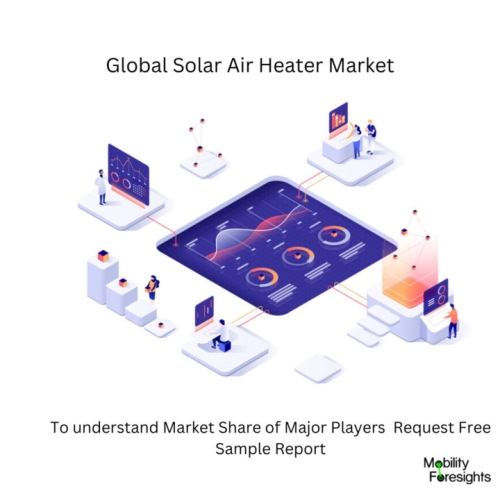
- Get in Touch with Us

Last Updated: Apr 25, 2025 | Study Period: 2023-2030
Solar air heating is a solar thermal method in which the sun's energy, insolation, is gathered and used to heat air via an absorbing media. Solar air heating is a heating method that uses renewable energy to heat or condition air for use in buildings or process heat applications.
It is often the most cost-effective of all solar technologies, particularly in commercial and industrial applications, because it solves the two most common uses of building energy in heating climates: space heating and industrial process heating.

The Global Solar Air Heater market accounted for $XX Billion in 2022 and is anticipated to reach $XX Billion by 2030, registering a CAGR of XX% from 2023 to 2030.
Performance investigation on a new solar air heater using phase change material/expanded metal mesh composite as heat storage unit. Phase change materials (PCMs) like paraffin and salt hydrates are frequently used in solar air heaters (SAHs) coupled with heat storage units.
PCMs' poor thermal conductivity causes heat to enter them slowly, which slows down charge/discharge and lowers the efficiency of heat storage units. Recently, a number of pricey solutions have been proposed to boost performance, including encapsulation and tubular containers.
By boosting the charge/discharge rate, the current delivers an innovative and straightforward solution to this problem. This method suggests embedding PCM in expanded metal meshes (EMMs). EMMs are Rabitz wire meshes with high thermal conductivities that are widely utilised in construction.
A revolutionary double-pass SAH design was created employing integrated PCM and a perforated absorber plate. SAH without PCM, SAH with PCM, and SAH with PCM/EMM were constructed as scenarios.Two mass flow rates were used in the experimental runs.
The obtained results demonstrate that, as compared to commercial SAHs at an air mass flow rate of 0.025 kg/s, PCM and PCM/EMM increase total heat gain and energy efficiency. As evidence that the EMM speeds up the discharge rate, the exhaust temperature in the SAH with PCM/EMM is greater in the evening than it is in the SAH utilising PCM. The innovative SAH employing PCM/EMM has a daily efficiency of 76%. However, utilising PCM and PCM/EMM lowers the energy efficiency since it lowers the temperature of the exhaust air.
| Sl no | Topic |
| 1 | Market Segmentation |
| 2 | Scope of the report |
| 3 | Abbreviations |
| 4 | Research Methodology |
| 5 | Executive Summary |
| 6 | Introduction |
| 7 | Insights from Industry stakeholders |
| 8 | Cost breakdown of Product by sub-components and average profit margin |
| 9 | Disruptive innovation in the Industry |
| 10 | Technology trends in the Industry |
| 11 | Consumer trends in the industry |
| 12 | Recent Production Milestones |
| 13 | Component Manufacturing in US, EU and China |
| 14 | COVID-19 impact on overall market |
| 15 | COVID-19 impact on Production of components |
| 16 | COVID-19 impact on Point of sale |
| 17 | Market Segmentation, Dynamics and Forecast by Geography, 2023-2030 |
| 18 | Market Segmentation, Dynamics and Forecast by Product Type, 2023-2030 |
| 19 | Market Segmentation, Dynamics and Forecast by Application, 2023-2030 |
| 20 | Market Segmentation, Dynamics and Forecast by End use, 2023-2030 |
| 21 | Product installation rate by OEM, 2023 |
| 22 | Incline/Decline in Average B-2-B selling price in past 5 years |
| 23 | Competition from substitute products |
| 24 | Gross margin and average profitability of suppliers |
| 25 | New product development in past 12 months |
| 26 | M&A in past 12 months |
| 27 | Growth strategy of leading players |
| 28 | Market share of vendors, 2023 |
| 29 | Company Profiles |
| 30 | Unmet needs and opportunity for new suppliers |
| 31 | Conclusion |
| 32 | Appendix |